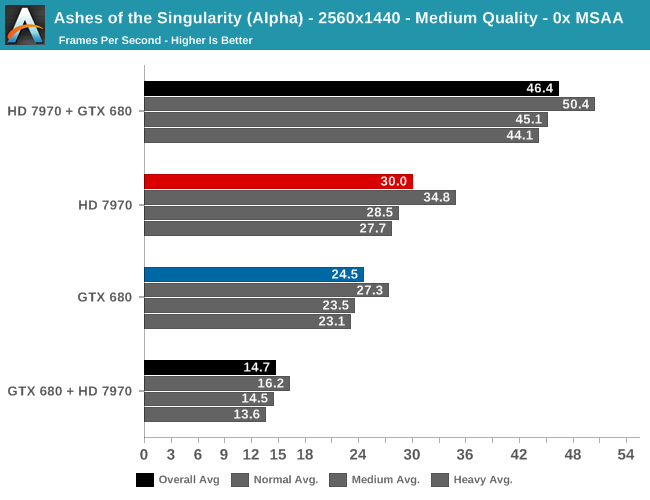GeForce + Radeon: Previewing DirectX 12 Multi-Adapter with Ashes of the Singularity
by Ryan Smith on October 26, 2015 10:00 AM ESTAshes GPU Performance: Single & Mixed 2012 GPUs
While Ashes’ mutli-GPU support sees solid performance gains with current-generation high-end GPUs, we wanted to see if those gains would extend to older DirectX 12 GPUs. To that end we’ve put the GeForce GTX 680 and the Radeon HD 7970 through a similar test, running the Ashes’ benchmark at 2560x1440 with Medium image quality and no MSAA.

First off, unlike our high-end GPUs there’s a distinct performance difference between our AMD and NVIDIA cards. The Radeon HD 7970 performs 22% better here, just averaging 30fps to the GTX 680’s 24.5fps. So right off the bat we’re entering an AFR setup with a moderately unbalanced set of cards.
Once we do turn on AFR, two very different things happen. The GTX 680 + HD 7970 setup is an outright performance regression, with performance 40% from the single GTX 680 Ti. On the other hand the HD 7970 + GTX 680 setup sees an unexpectedly good performance gain from AFR, picking up a further 55% to 46.4fps.
As this test is a smaller number of combinations it’s not clear where the bottlenecks are, but it’s none the less very interesting how we get such widely different results depending on which card is in the lead. In the GTX 680 + HD 7970 setup, either the GTX 680 is a bad leader or the HD 7970 is a bad follower, and this leads to this setup spinning its proverbial wheels. Otherwise letting the HD 7970 lead and GTX 680 follow sees a bigger performance gain than we would have expected for a moderately unbalanced setup with a pair of cards that were never known for their efficient PCIe data transfers. So long as you let the HD 7970 lead, at least in this case you could absolutely get away with a mixed GPU pairing of older GPUs.










180 Comments
View All Comments
medi03 - Monday, October 26, 2015 - link
Uhm, and what about 7970 simply being the faster card?Gigaplex - Monday, October 26, 2015 - link
That would explain why 7970+680 is faster than 680+7970, but not why 680 is faster than 680+7970.prtskg - Wednesday, October 28, 2015 - link
when 680 is in lead, not only it has to render frames but also assign work to 7970 and receive completed frames from it. For it to be slower than only 680 means assigning and receiving work is very slow on it.Hulk - Monday, October 26, 2015 - link
Could it be that the AMD/nVidia mixed setup performs better because each card has different strengths and weaknesses and they compliment each other rather than having two cards with the same strengths and weaknesses and therefore more probable bottlenecks?Just a thought.
DragonJujo - Monday, October 26, 2015 - link
They didn't include any direct comparisons to matched CrossFireX or SLI so it would be a bit premature. The idea itself is quite interesting in light of the GameWorks problems that show up in AMD because of the heavy tessellation (which can be limited).Ryan Smith - Monday, October 26, 2015 - link
As Ashes uses AFR, each card essentially has to stand on its own. Right now they only work together in as much as each gets assigned work, and then the secondary card ships off completed frames to the primary card for display queuing. There's no greater sharing of work; no opportunity for each card to work on what it does best.bug77 - Monday, October 26, 2015 - link
Technically, this is a major achievement. But in a world where multi-GPU setups are still in the single digits, these setups will be a niche of a niche.Manch - Monday, October 26, 2015 - link
I think you'll see more setups with mixed cards. If I don't have to toss my old card and simply by a new gen card with similar performance vs outlaying cash for SLI or cross fire off the bat that would be awesome. want to know if this can handle 4X x mixed cardsfingerbob69 - Wednesday, October 28, 2015 - link
I think this DX12 will lead to dual card set-ups becoming common if not the norm.I have a r9-280. In the next year or so I upgrade to either the next gen AMD OR nvidia with the 280 becoming the secondary to te new card's lead.
plopke - Monday, October 26, 2015 - link
why 3 shades of grey on some graphs(no pun intended) , maby i din't understand it , maby it is my screen but i can hardly make a distinction between the shades.